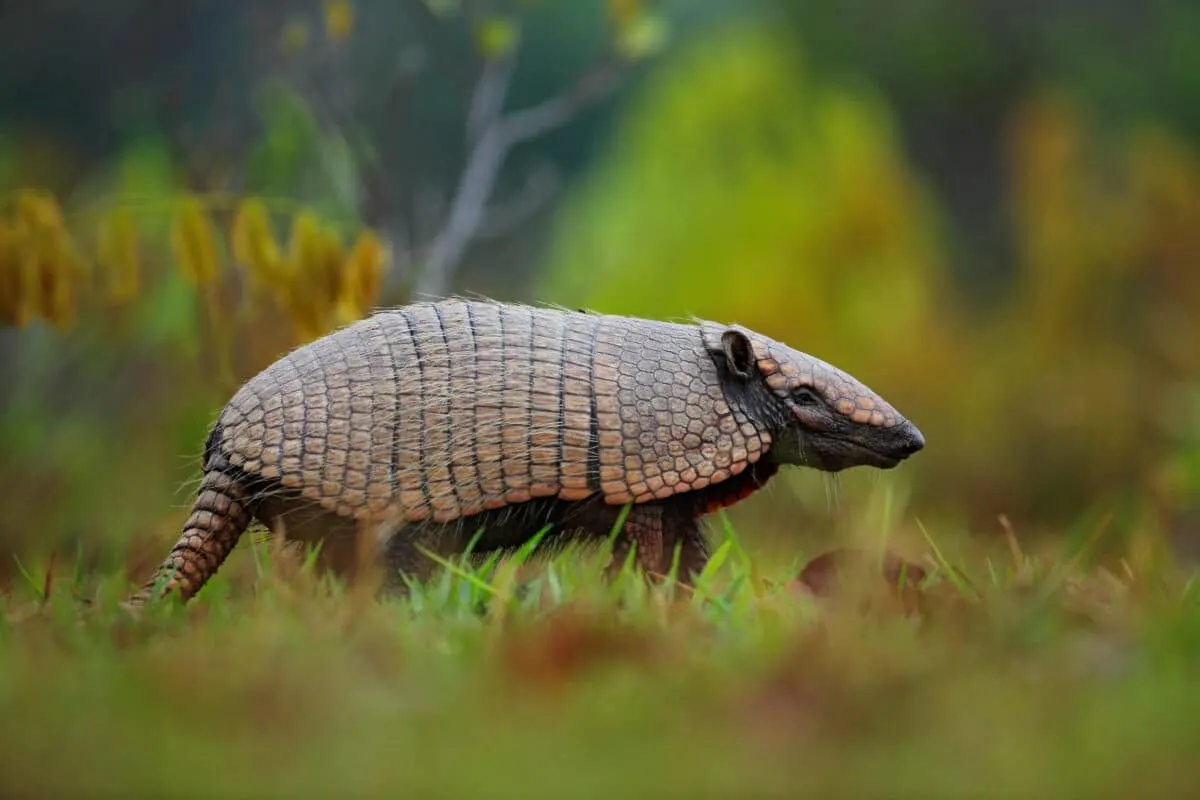Explore the fascinating world of armadillos! These special animals have always wowed nature lovers with shield shells and interesting features.
Join us in learning scientific knowledge about these remarkable mammals that inhabit the Americas.
From their impressive strong armor to their wide range of habitats, these animals offer something extraordinary at every corner, truly earning their place as marvels of the animal kingdom.
The Armadillo Family
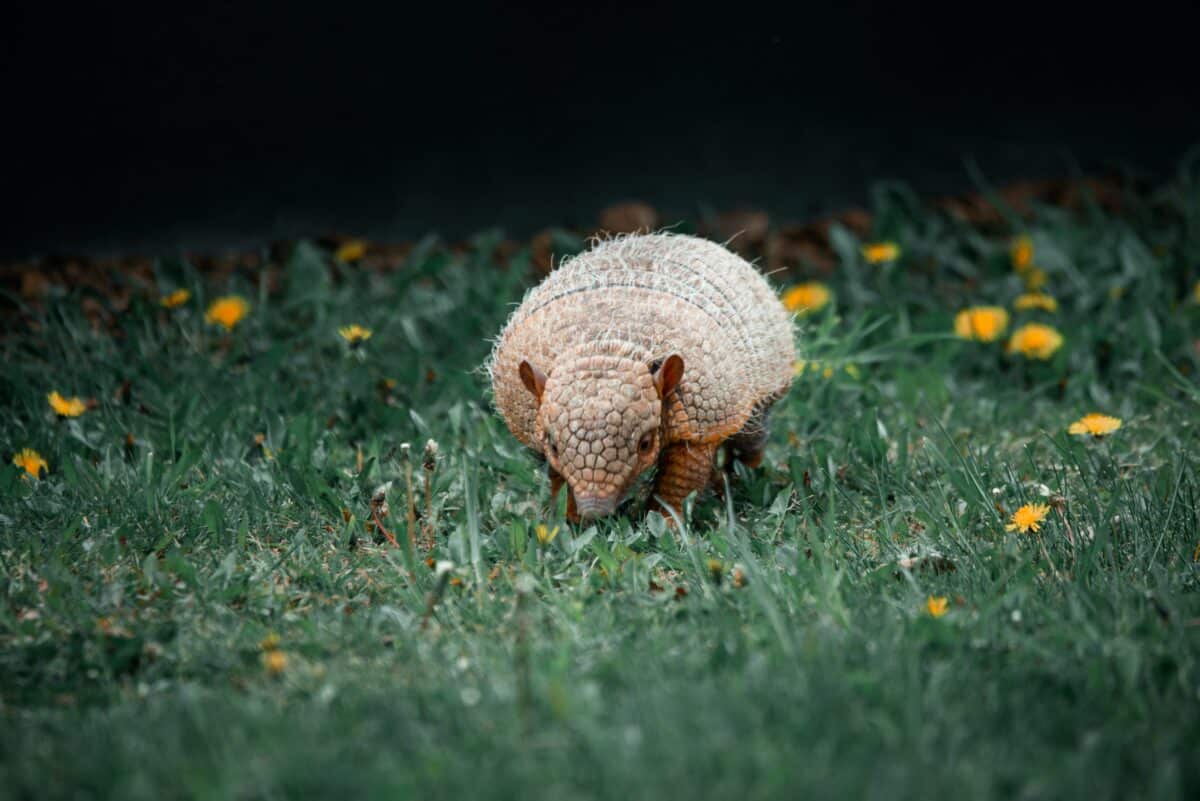
Armadillos are special animals that belong to a group called Cingulata. These mammals are known for their strong armor. There are different kinds of armadillos in this group, and each one has its own special traits.
The most famous and common armadillo is the nine-banded Armadillo. But there are also other family members that have interesting adaptations and features, like the six-banded Armadillo and the pink fairy armadillo.
Want to learn more about the Armadillo family? Learn with Britannica!
Physical Features
The most striking aspect of armadillos is their armor-like shell, which consists of overlapping bony plates known as scutes. These scutes provide a protective covering for the Armadillo’s body, shielding them from predators.
Interestingly, some armadillo species can roll into a ball, using their flexible joints to protect their vulnerable underbelly.
In addition to their armor, armadillos possess distinct snouts, which they use for foraging and digging. Their teeth are simple and peg-like, adapted for their primarily insectivorous diet.
Armadillos also have strong, curved claws that aid in digging burrows and finding food. These physical features make armadillos well-suited to their unique lifestyle.
Habitat and Distribution
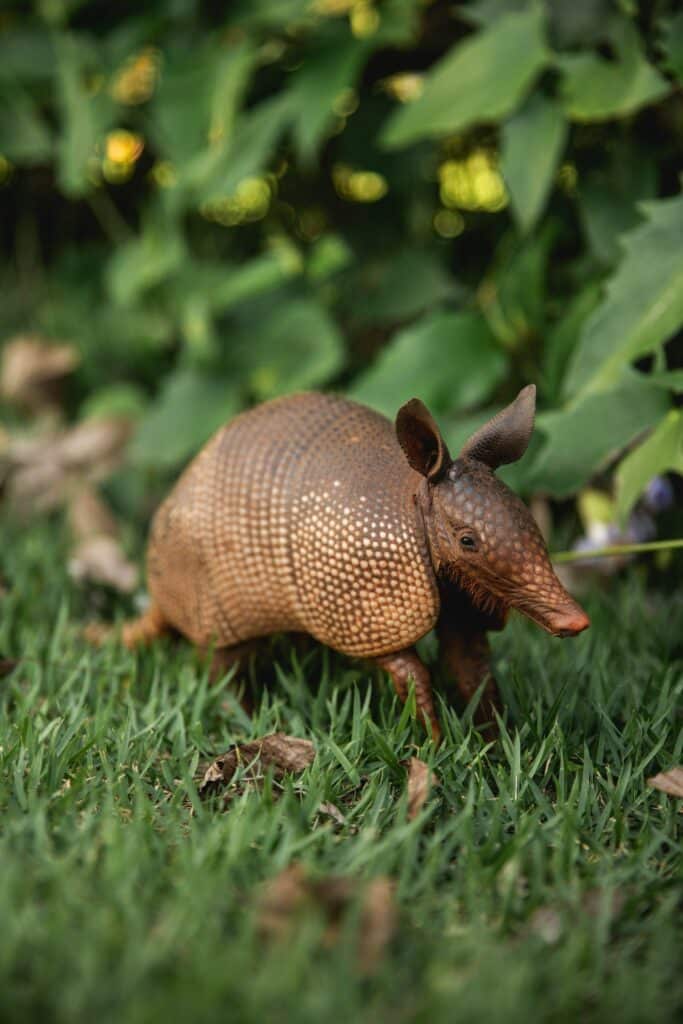
Armadillos are primarily found in warm regions of the Americas, including the southern United States, Central America, and South America.
The specific habitat preference of armadillos depends on the species and its adaptations. For example, some armadillos prefer more wooded areas with abundant vegetation, while others thrive in open grasslands.
Their distribution varies across the Americas, with some species having a limited range while others are more widespread. Let’s explore the different habitats and regions where armadillos can be found.
Nine-Banded Armadillo
The most prevalent and easily identifiable armadillo species is the Dasypus novemcinctus, commonly known as the ‘nine-banded’ Armadillo. Despite its name, this species typically has between seven and eleven movable bands on its armor.
Moreover, the nine-banded Armadillo possesses a brownish-gray, leathery shell composed of overlapping plates, providing flexibility and protection. It has a long snout and sharp claws, making it an adept digger.
These solitary creatures, including insects, small vertebrates, and plant matter, are nocturnal, venturing out at night for food. The nine-banded Armadillo is renowned for its ability to expand its population range, adapting well to human-altered environments.
Armadillo’s Adaptations
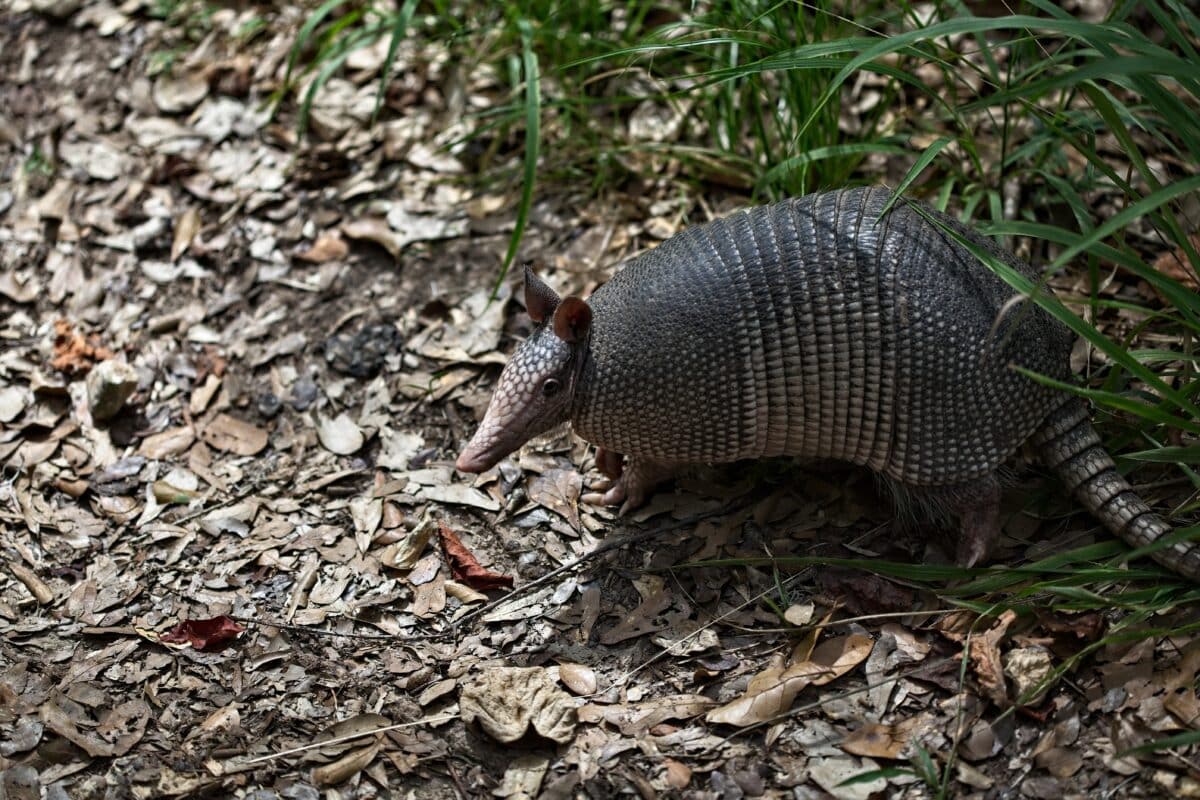
The Armadillo’s unique armor is crucial to its survival. The bony plates that make up their shells offer protection from predators, such as large birds and carnivorous mammals. Some armadillo species can roll into a ball, exposing only their armored exterior when threatened.
Additionally, armadillos possess an excellent sense of smell, which aids them in finding food and detecting potential predators. They have powerful digging claws that enable them to excavate burrows and search for insects and other small prey.
Some of these species have adapted to aquatic environments and are proficient swimmers, using their bloated stomachs as natural flotation devices. These have allowed armadillos to thrive in diverse habitats and survive various challenges.
Reproduction and Life Cycle
Armadillos have interesting ways of having babies. One of these is called delayed implantation, which means the fertilized eggs don’t attach to the uterus right away.
This special adaptation helps armadillos have their babies at the right time when the environment is good for them. Once the embryos attach to the uterus, the mom carries them for about 60 to 120 days until they are ready to be born.
The nine-banded Armadillo has a different and amazing way of reproducing called polyembryony. This means that from just one fertilized egg, four identical babies are formed, making them like genetic copies of each other.
This way of reproducing helps ensure that more babies survive. Armadillo babies are born with fur and open eyes. They grow up quickly and become adults in about a year, continuing the cycle of these animals life.
Armadillos and Humans
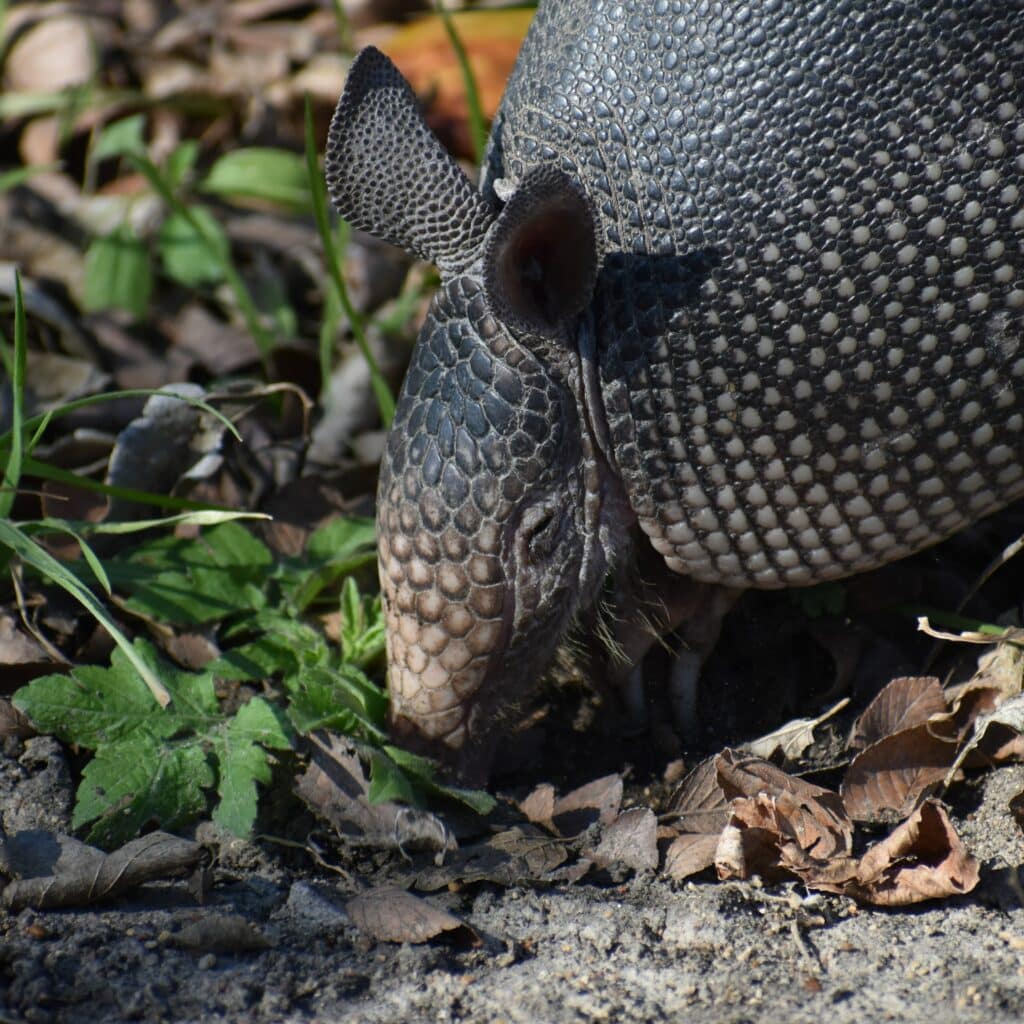
The relationship between this animal and humans is multifaceted. On the one hand, these creatures can be considered pests, as they sometimes cause damage to lawns and gardens by digging for food.
Armadillos provide to the ecosystem by playing a role in insect population control. Additionally, these animals are valued by hunters for their meat and their shells, which have various applications in crafts.
Moreover, armadillos have cultural significance in several regions. In Texas, for example, the nine-banded Armadillo is the state’s designated mammal (though, incidentally, only the ‘small’ mammal).
Additionally, armadillos have entered popular culture through books, cartoons, and folklore. Their unique appearance and intriguing behaviors continue to captivate scientists and the general public.
Conservation Status
Armadillos have adapted to changes caused by humans and can survive in many places. However, some species risk disappearing because they lose their environment. This is mainly due to the loss of their natural living spaces.
Hunting and accidents on roads also harm these animals populations in certain areas. To protect these animals and their homes, we need to take important steps to save them.
By understanding their differences and acting ahead of time, we can ensure these creatures continue to exist in the Americas for future generations to enjoy.
Don’t stop learning! Find out more with National Geographic.
Interesting Facts about Armadillos
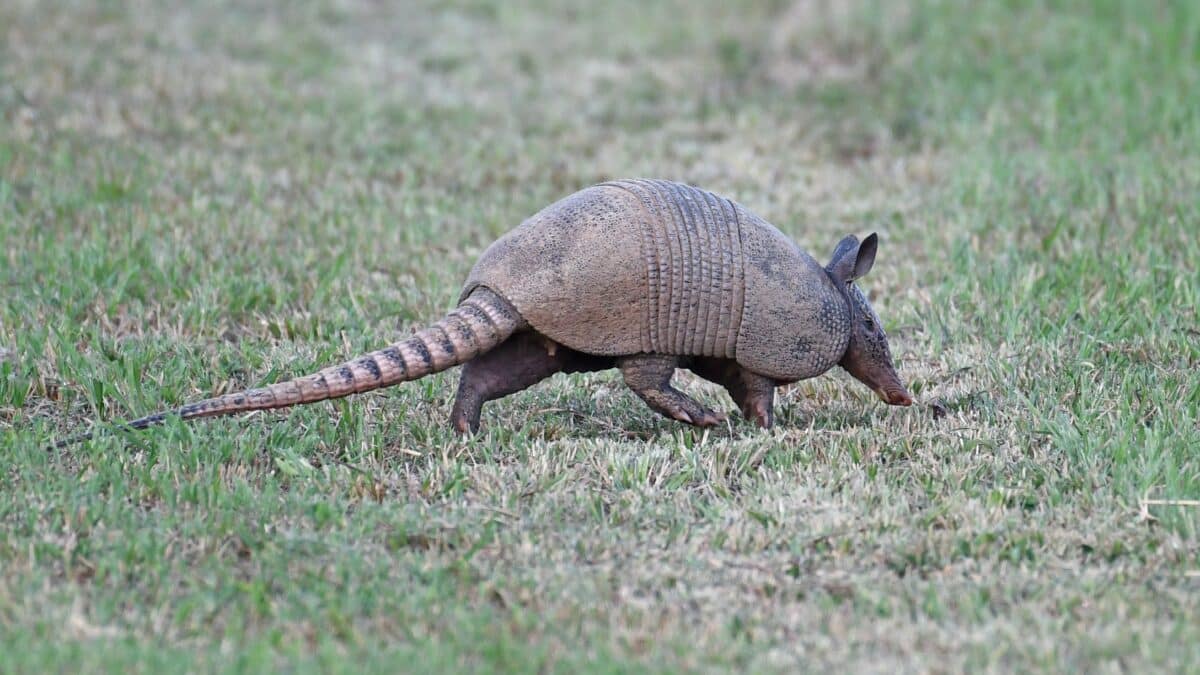
With their unique features and fasinating behaviors, Armadillos never surprise us. Let’s find some out some more aspects into these extraordinary mammals:
1. Armor Variations: Armadillos are known for their strong shells, but not all species have the same number of bands. This type Armadillo, for instance, can have between seven and eleven movable bands on its shell, which provides both flexibility and protection.
2. Exceptional Excavators: Armadillos are excellent diggers and create elaborate underground burrows. In fact, they hold the record for the largest burrow system dug by a mammal in North America. These burrows serve as crucial shelters, protecting these creatures from extreme temperatures and predators. Their ability to dig and create these caves is vital for their survival.
3. Nighttime Navigators: Armadillos are mostly awake at night and like colder temperatures for their nighttime activities. They have a slow metabolism, which helps them save energy. Certain species, such as the three-banded Armadillo, can even go into a deep sleep called torpor. During torpor, their body temperature drops a lot.
4. Dietary Diversity: Armadillos mostly eat insects. They rely on different small creatures without backbones as their main food. The specific things they eat can vary depending on the type of armadillo and where they live. Some armadillos also eat fruits, seeds, and even small animals like lizards and frogs.
5. Quick Babies: Armadillos can have babies very fast. Female breeds can give birth to one to three groups of babies in a year. When the nine-banded Armadillo has babies, it usually has four babies at a time. This fast way of having babies helps these creatures grow their population quickly when the conditions are good.
Key Points
Table: Discovering the Fascinating World of Armadillos
| Topic | Summary |
|---|---|
| The Armadillo Family | Armadillos belong to the order Cingulata and have various species with unique characteristics. |
| Physical Features | Armadillos have an armor-like shell, snouts for foraging, and strong digging claws. |
| Habitat and Distribution | Armadillos are found in warm regions of the Americas and have different habitat preferences. |
| Nine-Banded Armadillo | The most well-known species, Dasypus novemcinctus, has a flexible shell and nocturnal habits. |
| Armadillo’s Adaptations | Armadillos have armor for protection, a keen sense of smell, and adaptations for swimming. |
| Reproduction and Life Cycle | Armadillos have unique reproductive strategies, such as delayed implantation and polyembryony. |
| Armadillos and Humans | Armadillos can be considered pests but also play a role in the ecosystem and have cultural significance. |
| Conservation Status | Some armadillo species face conservation challenges due to habitat loss and other factors. |
| Interesting Facts | Armadillos have variations in armor, impressive digging abilities, and unique behaviors. |
The Bottom Line
Armadillos are truly amazing creatures that represent the marvels of the animal kingdom. Their tough shells, special adaptations, and varied habitats make them fascinating subjects for study.
Whether it’s the nine-banded Armadillo adapting to urban environments or their extraordinary reproductive strategy of polyembryony, these exceptional mammals capture our imagination.
Although these animals face challenges in a changing world, we can protect them through many efforts and by raising their importance.
By recognizing their importance in their natural life and taking steps to ensure we save their Environment, we can ensure that armadillos continue to mesmerize us with their extraordinary existence.
Next up: Unveiling the Mystique: Exploring Texas’s Mountain Lion Population, Explore Florida’s Bull Shark Population, River Showdown: Otter Outwits A Crocodile, Explore Pennsylvania’s Coyote Population, Meet New York’s Urban Coyote Population.
Join our Forum for free today!

- Top 10 Savanna Animals - June 3, 2024
- American Bulldog – Cute Ball of Fear - May 31, 2024
- Mammoths Vs. Mastodons - May 31, 2024

